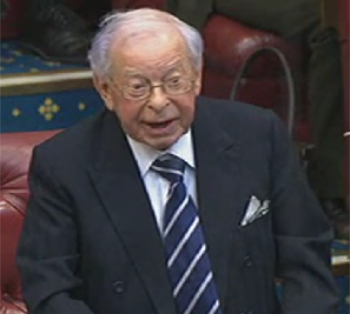Barnett consequentials and the Barnett guarantee
Contents |
[edit] Background
The Barnett formula was first used in 1978, for Scotland, introduced by and named after the then Labour chief secretary to the Treasury, Joel Barnett. It was extended to Northern Ireland in 1979 and to Wales in 1980.
It was meant as a temporary measure to avoid annual negotiations on funding allocations between the UK’s nations. The formula was used to determine the level of UK government spending on public services in Scotland, Wales and Northern Ireland until 1999, when devolution in the UK was brought in under the then Labour government.
Since devolution, the UK Government allocates funding in two ways, either to the UK as a whole, or specifically just for England when the funding is spent on a policy area where the devolved administrations are responsible (including health, education, local government and now Building Safety), block grants of the devolved administrations are set by the Barnett formula.
[edit] The Barnett formula
The Barnett formula refers to the way funding is calculated, effectively the yearly change to the block grant (the largest of the grants provided to the devolved administrations by the UK government) is carried out by a formula which aims to give each nation the same pounds-per-person change in funding each year.
[edit] Barnett consequentials
When additional public expenditure is planned in England, the corresponding additions which are made to the devolved administrations' funding allocations are referred to as Barnett consequentials, aiming to make fair provision to devolved nations of Scotland, Wales and Northern Ireland.
[edit] The Barnett guarantee
The Barnett guarantee, is effectively the same process as the consequentials and formula but as a guarantee it gives devolved administrations increased funding certainty, enabling them to decide how and when to provide support, rather than loans or the traditional Barnett consequentials. The guarantee thus allows devolved administrations to spend additional funding allocated by the Barnett guarantee without having to wait for it to be first spent in England.
The Barnett guarantee was established in July of 2020 as a result of the coronavirus pandemic and requests from the devolved administrations for more borrowing powers that followed. The Barnett guarantee set out how much additional funding the UK Government would provide to each of the devolved administrations to address the pressures of the pandemic in 2020-21. The Barnett guarantee has also been raised in connection to building safety since the Grenfell tragedy and in particular with reference to remediation programmes developed by each of the devolved nations, such as the Scottish Building Safety Levy.
[edit] The Barnett guarantee and Building Safety remediation
The Residential Property Developer Tax (RPDT) was a Corporation Tax supplement levied by the UK Government on the UK’s largest residential property developers,introduced on 1 April 2022. The aim for the tax was to obtain a contribution towards the cost of dealing with defective cladding in the UK’s high-rise housing stock, limited to the largest residential property developers by each group having an annual allowance of £25 million, with only profits from residential property development activities above this amount being subject to the tax.
Only residential development companies liable for UK Corporation Tax fall within scope of RPDT, which is charged at 4% on residential property development profits that exceed their annual allowance. The intention being to raise at least £2 billion from RPDT over a ten-year period, with £200 million generated in the first year. As a UK-wide tax where revenues are used to fund spending on cladding remediation in England, the Scottish Government receive Barnett consequentials, approximately £194 million over the expected ten-year period. The Scottish Government has committed to spending all Barnett consequentials generated from RPDT on cladding remediation in Scotland.
[edit] Related articles on Designing Buildings
Featured articles and news
OpenUSD possibilities: Look before you leap
Being ready for the OpenUSD solutions set to transform architecture and design.
Global Asbestos Awareness Week 2025
Highlighting the continuing threat to trades persons.
Retrofit of Buildings, a CIOB Technical Publication
Now available in Arabic and Chinese aswell as English.
The context, schemes, standards, roles and relevance of the Building Safety Act.
Retrofit 25 – What's Stopping Us?
Exhibition Opens at The Building Centre.
Types of work to existing buildings
A simple circular economy wiki breakdown with further links.
A threat to the creativity that makes London special.
How can digital twins boost profitability within construction?
The smart construction dashboard, as-built data and site changes forming an accurate digital twin.
Unlocking surplus public defence land and more to speed up the delivery of housing.
The Planning and Infrastructure Bill
An outline of the bill with a mix of reactions on potential impacts from IHBC, CIEEM, CIC, ACE and EIC.
Farnborough College Unveils its Half-house for Sustainable Construction Training.
Spring Statement 2025 with reactions from industry
Confirming previously announced funding, and welfare changes amid adjusted growth forecast.
Scottish Government responds to Grenfell report
As fund for unsafe cladding assessments is launched.
CLC and BSR process map for HRB approvals
One of the initial outputs of their weekly BSR meetings.
Building Safety Levy technical consultation response
Details of the planned levy now due in 2026.
Great British Energy install solar on school and NHS sites
200 schools and 200 NHS sites to get solar systems, as first project of the newly formed government initiative.
600 million for 60,000 more skilled construction workers
Announced by Treasury ahead of the Spring Statement.
























